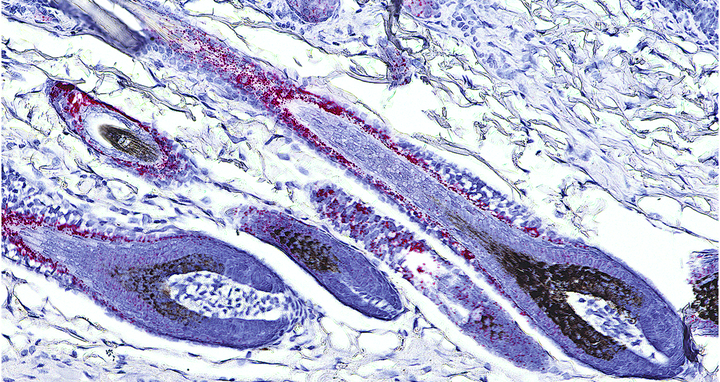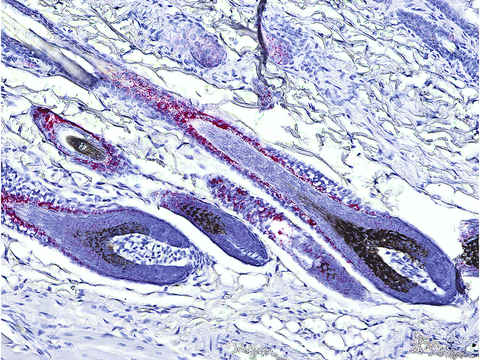Treating skin diseases with ACE2 inhibitors
It all began a few years ago, with an unexpected discovery: “A PhD student on my team wanted to take a closer look at how the enzyme ACE2 functioned in the bloodstream of mice,” says Professor Michael Bader, who leads the Molecular Biology of Peptide Hormones Lab at the Max Delbrück Center. The student worked with white mice, some of which were missing the gene for ACE2. “He found that he could identify the knock-out mice without any genetic testing,” says Bader. “The mice without the ACE2 gene had yellowish fur instead of white.”
Elevated melanin production
Bader and his team hypothesized that ACE2 somehow affected the production of the pigment melanin – which, as well as affecting the color of the mice’s fur, would also affect the darkness of the skin. They hope this discovery will now pave the way for new therapies for skin diseases that disrupt melanin production and the synthesis of melanocyte-stimulating hormone (MSH). “We want to develop ACE2 inhibitors that can be applied as an ointment and will alleviate the symptoms of conditions such as vitiligo, psoriasis, and acne,” says Bader. The project is receiving support from the LEO Foundation, a Danish foundation that supports research into innovative treatments for skin diseases. In early February, it awarded Bader 3.9 million krone (around €520,000) in funding for the next three years.
“MSH, which binds to the MC1R receptor in pigment-forming melanocytes, is the most important regulator of melanin production. It also has a very powerful anti-inflammatory effect in the skin,” says Bader. MC1R has therefore long been a pharmacological target for inflammatory skin diseases and for preventing melanomas. Several agonists – active substances that imitate the effect of MSH – have already received approval or are in development.
A stronger immune defense
“We initially suspected that ACE2 limited melanin production in mouse and human skin by destroying MSH,” says Bader. “But it seems not to be that straightforward. What is true, though, is that the enzyme – which also helps coronaviruses gain access to human cells – impairs the hormone’s function. Inhibiting ACE2 could therefore be a new strategy for treating dermatological diseases. “It makes more MSH available, which both darkens the skin and increases its immune defense,” says Bader.
ACE2 (seen here as red dots) is present in large quantities in the hair follicles of the skin.
But there is one catch: In the bloodstream, ACE2 acts as a protective enzyme and is involved in the renin-angiotensin system. The body uses this system to regulate blood pressure, and fluid and electrolyte levels. “That’s why we want to develop a topical application for the drug, so it can be applied locally to the skin. “We’ve already tested a number of established ACE2 inhibitors, but they weren’t suitable for topical use.”
A treatment for vitiligo
Using the LEO Foundation funding, Bader will work with the group led by Dr. Marc Nazaré, a chemist at the Leibniz-Forschungsinstitut für Molekulare Pharmakologie (FMP) in Berlin, to chemically alter established ACE2 inhibitors so they are more easily absorbed by the skin but retain their inhibiting effect. To do so, the researchers will conduct experiments using artificial skin and pig skin, and then test the altered substances in a vitiligo mouse model.
Although the white patches are benign, they can cause psychological distress for many people.
Vitiligo is an autoimmune disease that researchers suspect is caused by the immune system attacking melanocyte precursor cells. The condition causes sharply demarcated white patches on the skin. “Although they’re benign, they can cause psychological distress for many people,” says Bader. “So I’d be delighted if we managed to develop an effective therapy with minimal side effects for vitiligo and other inflammatory skin conditions that involve MSH.”
Bader concedes that the ACE2 inhibitor doesn’t stop the loss of melanocytes, “but we could use it to encourage the remaining cells to produce more melanin – and thereby preserve the original skin tone.” Bader also notes that the new drug sadly won’t be any use against COVID-19: “ACE2 inhibitors don’t affect the enzyme’s ability to function as a receptor for SARS-CoV-2.”
Text: Anke Brodmerkel









